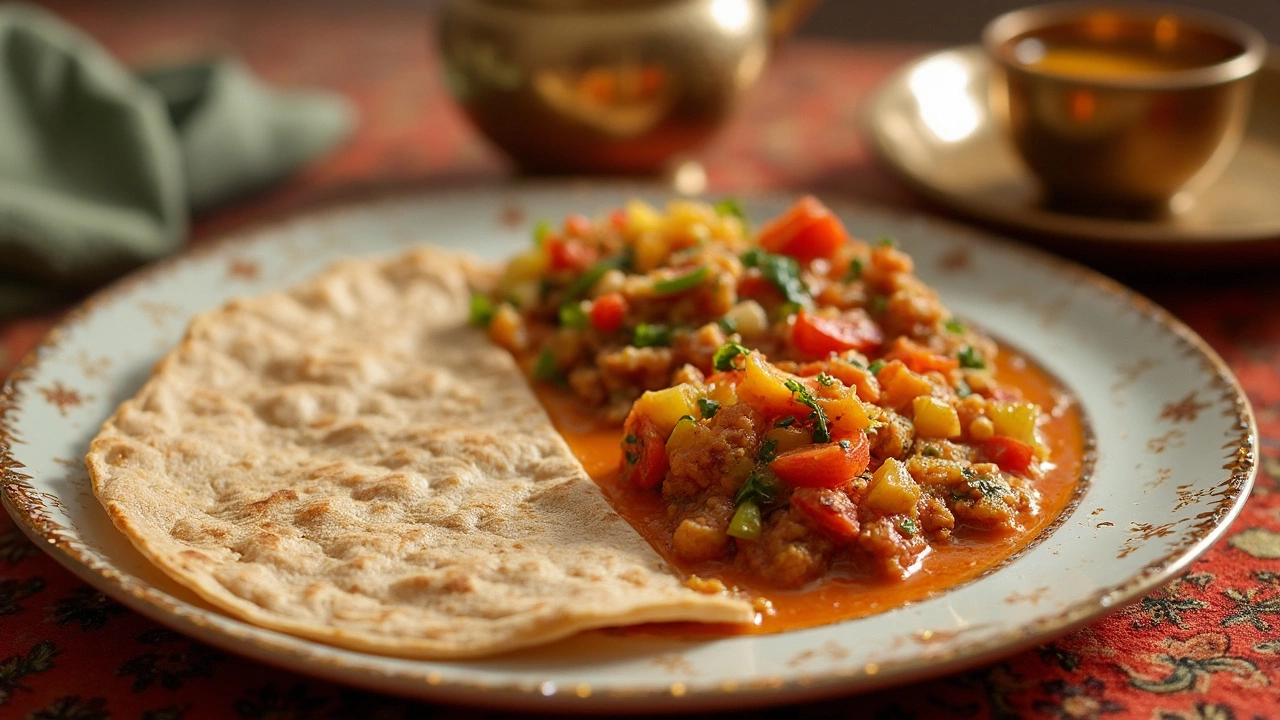Roti Calories: Whole Wheat vs. Refined Flour Explained
 Feb, 17 2025
Feb, 17 2025
Ever wondered if the roti you're eating is contributing a little more to your daily calorie count than you'd like? It's a common question for many of us. Let's dive directly into how the two main types of rotis, whole wheat and refined flour, stack up in terms of calories and nutritional value.
Whole wheat rotis, made from whole grains, are known to be healthier. But what about the calories in 1 roti made from refined flour? Typically, you're looking at around 70-100 calories in 1 roti of whole wheat, depending on size and ingredients. A single roti with ghee can take it up a notch due to the added fat, while pairing a roti with sabzi might influence your calorie intake as well.
Refined flour rotis, often softer, have fewer fibers compared to whole wheat and may have similar or slightly fewer calories than their whole wheat counterparts, but they lag in nutritional benefits.
- Understanding Roti Types
- Calorie Content Breakdown
- Health Benefits Comparison
- Tips for Healthy Roti Consumption
Understanding Roti Types
When it comes to rotis, it feels like a small choice, but it can make a big difference to your daily nutrition. Rotis are a staple in many Indian households, and knowing which one suits your health needs can be quite a relief.
Whole Wheat Roti
These are made from whole wheat flour, which includes bran, germ, and endosperm. This means it retains more fiber and nutrients compared to refined flour. Whole wheat rotis are often praised for their health benefits and considered superior when it comes to a balanced diet. A nutritionist once said,
"Whole wheat roti contributes to daily fiber intake and keeps you fuller for longer." – Dr. R. Kapoor
In contrast, they're a bit denser and have a slightly nuttier flavor. But what's inside packs a punch.
Refined Flour Roti
Also known as maida roti, refined flour rotis lack the nutrients found in whole wheat. The refining process removes most of the fiber, leaving behind a flour that, while smooth and soft, is mostly about the texture rather than nutrition. On the brighter side, they appear softer and often seem more appealing in dishes requiring a tender bite but may have nearly the same calories in roti as whole wheat versions.
Choosing refined over whole wheat creates a problem, as you're losing essential fibers. An easy fix? Gradually incorporate more whole wheat rotis into your meals. It's a manageable change that could benefit everyone at the table.
Roti Nutrition Simplified
Check out this simple comparison of nutrients per 100 grams:
| Type | Calories | Fiber (g) |
|---|---|---|
| Whole Wheat Roti | 237 | 9.2 |
| Refined Flour Roti | 364 | 2.7 |
There's a clear case for choosing whole wheat, but the choice isn't always black and white. Finding a balance that fits your lifestyle and health goals is key. And remember, health isn't about strict rules; it's about small, consistent, and sustainable changes.
Whichever type of roti you're leaning toward, understanding their differences empowers you to make smarter, dietary choices that'll help you feel good and stay healthy!
Calorie Content Breakdown
Navigating the world of rotis might seem simple, but when you dive into the nitty-gritty of calorie content, things get interesting. Knowing how much calories in 1 roti is crucial if you're mindful of your intake.
Whole Wheat Roti
Whole wheat rotis are a staple for many of us, thanks to their nutritional benefits. Per one medium-sized roti made from whole wheat, you're ingesting about 70-100 calories. This includes a good balance of carbohydrates, proteins, and fiber. The fiber is a real gem here—it helps with digestion and provides a feeling of fullness that refined flour can't match.
Refined Flour Roti
In comparison, the refined flour roti might pack similar calories but lacks the rich nutrients. Expect around 80-110 calories in 1 roti of refined flour. These rotis might be fluffier but come with fewer fibers and potentially higher blood sugar levels due to refined carbs.
"Refined flour options give the feel of eating less while often adding unnecessary calories," says Dr. Kavita Sharma, a leading nutritionist.
What About Additions?
Adding ghee or pairing your roti with sabzi changes things up. A roti with ghee can add an extra 20-40 calories based on the ghee quantity, enhancing flavor but also increasing fat intake. Meanwhile, calories in 1 roti and sabzi depend largely on how the sabzi is cooked. Cream-based gravies or potato-based sabzis may double the total calories.
| Type | Calories | Notes |
|---|---|---|
| Whole Wheat Roti | 70-100 | High fiber |
| Refined Flour Roti | 80-110 | Less nutrients |
| Roti with Ghee | 90-140 | Enhanced flavor |
So, if you're tracking your diet, consider these numbers. Whole wheat might be your go-to for a healthier lifestyle while refined flour offers a softer texture at a cost. Craft your meals with this knowledge and feel good about your choices!

Health Benefits Comparison
Choosing between whole wheat and refined flour rotis boils down to understanding their health benefits. Let's break it down!
Why Whole Wheat Wins
Whole wheat is packed with nutrients. It contains more fiber, which is great for digestion. Fiber helps keep you feeling full longer, meaning you're less likely to snack throughout the day. Plus, whole wheat retains its bran and germ layers, which contain essential vitamins and minerals.
"Whole grains like wheat are crucial for preventing diseases such as heart disease and type 2 diabetes," states the National Institute of Health.
Here's a quick overview of what whole wheat offers:
| Nutrient | Whole Wheat Roti | Refined Flour Roti |
|---|---|---|
| Fiber | 3g | 1g |
| Magnesium | 22mg | 6mg |
| Calories in 1 roti | 70-100 | 70-100 |
Where Refined Flour Falls Short
Refined flour is stripped of its bran and germ, which removes a lot of nutrients. While it may not differ much in calorie count, it lacks the fiber that whole wheat provides, leading to quicker digestion and possibly more frequent hunger pangs. The quick intake of these refined carbs can also lead to spikes in blood sugar levels.
For a healthier lifestyle, choosing whole wheat rotis over refined ones can be beneficial. If you're worried about the taste, try a gradual switch. Mix some whole wheat flour into your regular refined flour to get used to the texture and flavor.
Switch a few more steps forward by incorporating healthier pairings like sabzi, which can help balance your meal.
Tips for Healthy Roti Consumption
Trying to keep your meals healthier and still enjoy rotis? You're not alone! Here are some practical tips to make your rotis more nutritious without compromising on taste.
Choose the Right Flour
Picking the right flour is crucial. Go for whole wheat roti when possible. It's got more fiber, which keeps you fuller longer, compared to refined flour. That means fewer cravings between meals.
Watch Your Portions
Sometimes, it's not what you eat, but how much! Stick to one roti per meal if you're watching calories. Pair it with a generous helping of vegetables or dal to balance it out.
Cook with Less Oil
Use a non-stick pan to make your roti without too much oil or ghee. This simple switch can significantly cut down on unwanted calories.
Blend in Other Grains
Experiment by adding flour from other grains like oats or millet to your dough. It boosts nutrition and offers different flavors to your everyday meals.
Use Ghee Sparingly
While ghee brings flavor, be mindful of its calorie content. A drizzle goes a long way!
Stay Hydrated
Don’t forget the role of water! Sometimes, your hunger might simply be thirst. Keep sipping water alongside your meals. It helps with digestion and keeps you from overeating.
By following these tips, you can enjoy your favorite roti while keeping it as a healthy part of your diet!